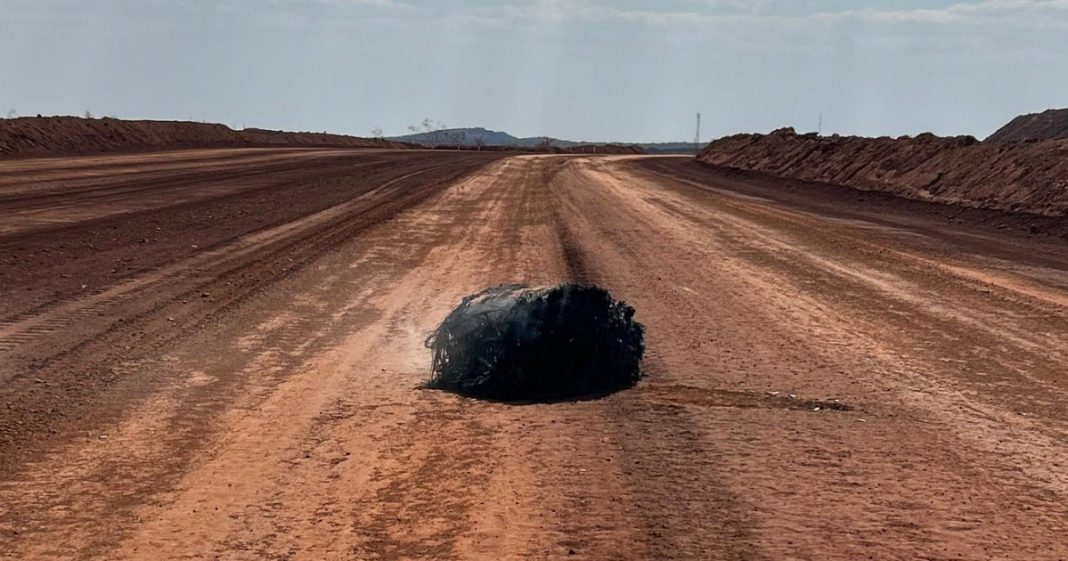Imagine trekking through the vast, ancient expanse of the Australian outback, where the horizon stretches endlessly under a brilliant, indifferent sky. Your footsteps crunch on arid earth, and the only sounds are the rustle of dry grass and the distant bleating of sheep. Now, imagine stumbling upon something utterly alien amidst this familiar landscape: a massive, charred chunk of metal, seemingly dropped from the heavens. This isn’t the plot of a sci-fi movie, but a very real, very bewildering discovery that has gripped the attention of locals and space enthusiasts alike.
A Cosmic Collision in the Outback
The scene unfolded on a remote sheep farm in New South Wales, where a rather unassuming farmer made the extraordinary find. What he encountered was no ordinary rock or piece of agricultural equipment. It was a significant, blackened fragment, large enough to make you pause and wonder about its origins. The object bore all the hallmarks of an intense re-entry through Earth’s atmosphere: scorched, twisted, and with an almost alien quality that defied terrestrial explanation. It was a stark, undeniable piece of a puzzle, lying silently in the red dust, posing a singular question: what exactly is this?
Initial investigations quickly pointed away from anything natural or locally manufactured. The sheer scale and the distinct charring suggested something far more dramatic than a mere meteor. This wasn’t a pristine space rock; it was clearly engineered, now ravaged by the incredible forces of atmospheric drag and friction. “It looked like something straight out of a sci-fi movie, all burnt and twisted,” remarked a local farmer, still trying to wrap his head around the discovery. The sheer unexpectedness of finding such a substantial artifact in such a secluded spot only amplified the mystery.
From Orbit to Outback: Unpacking the Space Junk Theory
While the visual impact alone was enough to spark global curiosity, the leading theory quickly coalesced around a more grounded, yet equally fascinating, explanation: space junk. Specifically, experts are looking at fragments from a rocket re-entry. Earth’s orbit is increasingly cluttered with defunct satellites, spent rocket stages, and various bits of debris. While much of this burns up harmlessly, larger components can survive the fiery descent, making it all the way to the surface.
The hunt for definitive answers is underway, involving teams studying trajectory data and the composition of the object itself. The precise origin of this particular chunk is still being verified, but it’s believed to be part of a larger piece of space hardware that recently made an uncontrolled re-entry. The sheer size of this fragment, however, is what makes it stand out. It serves as a stark reminder that what goes up, must eventually come down – and sometimes, it lands on an unsuspecting sheep farm.
The Echoes of a Crowded Cosmos
This remarkable discovery isn’t just a quirky news item; it’s a tangible piece of a much larger, ongoing conversation about space debris. As humanity launches more and more into orbit, the risk of such re-entries – and their potential impact zones – grows. While the chances of being hit by space junk are astronomically low, incidents like this highlight the increasing congestion in Earth’s immediate cosmic neighborhood.
The Australian desert has become an unexpected museum for this space artifact, reminding us of our growing footprint beyond Earth’s atmosphere. It’s a testament to human ingenuity reaching for the stars, and an equally potent symbol of the consequences of that ambition. For now, the scorched chunk of suspected space junk sits as a silent, powerful story-teller, connecting a quiet corner of Australia directly to the vast, bustling expanse of space above.




